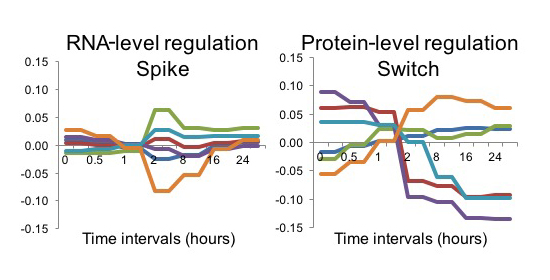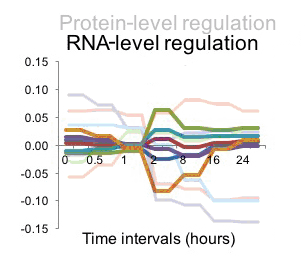|
|
RNA quick — Protein slow
A team of scientists has uncovered intricate signaling as it applies to making RNA and proteins. Both occur almost at the same moment, but at two unique frequencies.
"To make a protein, first we need to make a messenger RNA molecule from a DNA gene, and then secondly make proteins from these RNA molecules. Both processes are coupled [together]," explains Christine Vogel PhD, and assistant professor in the New York University Department of Biology. She is also a senior author on the study. The research includes scientists from the National University Singapore and the Max-Delbruck-Center, Berlin, Germany and appears in the journal Molecular Systems Biology.
The coupling of these two processes is comparable to the movement of a person walking on a moving escalator. Both happen at the same time. But the person can move with the escalator or choose to walk faster while on the escalator. Taking a closer look at the two processes, the science reveals frequency changes between RNA and protein production in response to outside stimulus - similar to walking faster than the escalator moves.
"Until recently, researchers thought that the movement of the escalator is more important to the cellular response," Vogel explains. "We now see, under some circumstances, the person's walking determines the overall outcome."
In biology, both of the processes to make RNAs and proteins, have different frequency patterns over a similar period of time.
Study scientists took a closer look at how the two processes exactly occur over time and their results showed distinct differences between DNA and mRNA signals.
Making RNA from DNA was pulse-like — a brief signal over a period of time that returned to normal levels quickly.
In contrast, the making of protein from RNA was akin to an on/off switch: once started, levels remained constant for a longer period before reverting back to being dormant.
While the reasons for these differences in cell behavior are still unknown, researchers feel the answer may lie in the nature of the two tasks.
"Making RNA messages from DNA is a relatively low-energy and simple process. So it makes sense to see frequent, or pulsating, signals at this stage.
"By contrast, it is very costly for a cell to make protein, an intricate undertaking requiring a great deal of time and energy. "
Christine Vogel PhD, Assistant Professor, New York University's Department of Biology, and one of the senior authors of the study.
Abstract
The relative importance of regulation at the mRNA versus protein level is subject to ongoing debate. To address this question in a dynamic system, we mapped proteomic and transcriptomic changes in mammalian cells responding to stress induced by dithiothreitol over 30 h. Specifically, we estimated the kinetic parameters for the synthesis and degradation of RNA and proteins, and deconvoluted the response patterns into common and unique to each regulatory level using a new statistical tool. Overall, the two regulatory levels were equally important, but differed in their impact on molecule concentrations. Both mRNA and protein changes peaked between two and eight hours, but mRNA expression fold changes were much smaller than those of the proteins. mRNA concentrations shifted in a transient, pulse-like pattern and returned to values close to pre-treatment levels by the end of the experiment. In contrast, protein concentrations switched only once and established a new steady state, consistent with the dominant role of protein regulation during misfolding stress. Finally, we generated hypotheses on specific regulatory modes for some genes.
Synopsis
Thumbnail image of graphical abstract
The contribution of mRNA and protein level regulation in the mammalian endoplasmic reticulum stress response is deconvoluted by analyzing time-series protein and matching mRNA concentrations with a new statistical tool.
Protein and mRNA concentrations are quantified at different time points, generating a high-confidence dataset of 1,237 genes/mRNAs.
A new statistical tool quantifies the contribution of regulatory processes and shows that mRNA and protein level regulation play similarly important roles.
mRNA and protein level regulation have different dynamics: mRNA concentrations spike in their change and return to pre-perturbation levels, while protein concentrations switch in their behavior and reach a new steady-state.
Hypotheses on modes of regulation for several groups of genes are presented.
The study was supported, in part, by a grant from the National Institutes of Health (R01 GM113237) and a Singapore Ministry of Education Tier 2 grant (R-608-000-088-112).
Return to top of page
|
|
|
Feb 8, 2016 Fetal Timeline Maternal Timeline News News Archive


RNA exists in a short spike — while Proteins are produced over a longer time interval.
Image Credit: Christine Vogel Laboratory, New York University
|
|
|
|




